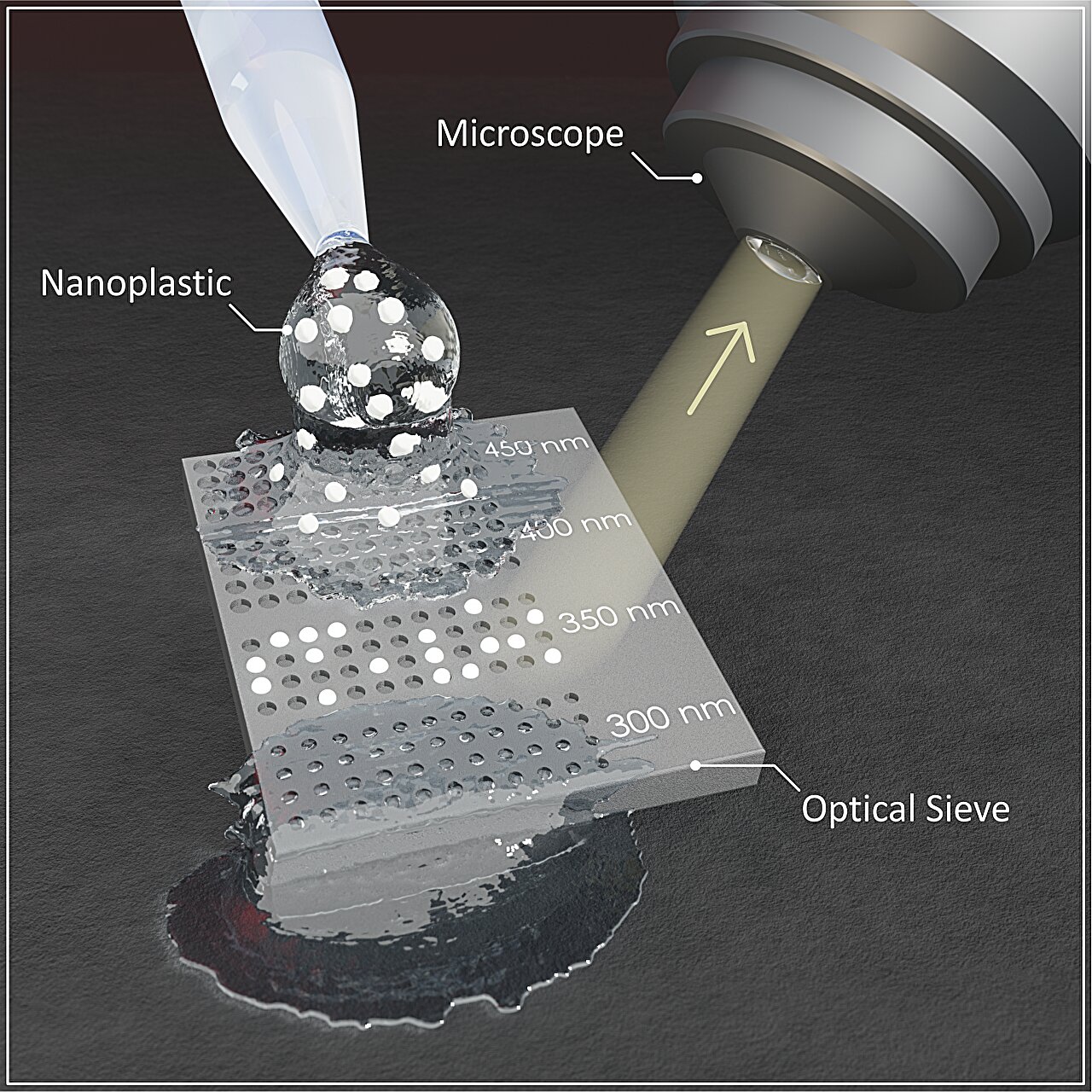Tech
Color-changing strip enables affordable nanoplastic analysis using ordinary microscope

A joint team from the University of Stuttgart in Germany and the University of Melbourne in Australia has developed a new method for the straightforward analysis of tiny nanoplastic particles in environmental samples. One needs only an ordinary optical microscope and a newly developed test strip—the optical sieve. The research results have now been published in Nature Photonics.
“The test strip can serve as a simple analysis tool in environmental and health research,” explains Prof. Harald Giessen, Head of the 4th Physics Institute of the University of Stuttgart. “In the near future, we will be working toward analyzing nanoplastic concentrations directly on site. But our new method could also be used to test blood or tissue for nanoplastic particles.”
Plastic waste is one of the central and acute global problems of the 21st century. It not only pollutes oceans, rivers, and beaches but has also been detected in living organisms in the form of microplastics. Until now, environmental scientists have focused their attention on larger plastic residues.
However, it has been known for some time that an even greater danger may be on the horizon: nanoplastic particles. These tiny particles are much smaller than a human hair and are created through the breakdown of larger plastic particles. They cannot be seen with the naked eye. These particles in the sub-micrometer range can also easily cross organic barriers such as the skin or the blood-brain barrier.
Because of the small particle size, their detection poses a particular challenge. As a result, there are not only gaps in our understanding of how particles affect organisms but also a lack of rapid and reliable detection methods.
In collaboration with a research group from Melbourne in Australia, researchers at the University of Stuttgart have now developed a novel method that can quickly and affordably detect such small particles. Color changes on a special test strip make nanoplastics visible in an optical microscope and allow researchers to count the number of particles and determine their size.
“Compared with conventional and widely used methods such as scanning electron microscopy, the new method is considerably less expensive, does not require trained personnel to operate, and reduces the time required for detailed analysis,” explains Dr. Mario Hentschel, Head of the Microstructure Laboratory at the 4th Physics Institute.
The “optical sieve” uses resonance effects in small holes to make the nanoplastic particles visible. A study on optical effects in such holes was first published by the research group at the University of Stuttgart in 2023. The process is based on tiny depressions, known as Mie voids, which are edged into a semiconductor substrate.
Depending on their diameter and depth, the holes interact characteristically with the incident light. This results in a bright color reflection that can be seen with an optical microscope. If a particle falls into one of the indentations, its color changes noticeably. One can therefore infer from the changing color whether a particle is present in the void.
“The test strip works like a classic sieve,” explains Dominik Ludescher, Ph.D. student and first author of the publication. Particles ranging from 0.2 to 1 µm can thus be examined without difficulty. The particles are filtered out of the liquid using the sieve in which the size and depth of the holes can be adapted to the nanoplastic particles, and subsequently by the resulting color change can be detected. This allows us to determine whether the voids are filled or empty.”
The novel detection method used can do even more. If the sieve is provided with voids of different sizes, only one particle of a suitable size will collect in each hole. “If a particle is too large, it won’t fit into the void and will simply be flushed away during the cleaning process,” says Ludescher.
“If a particle is too small, it will adhere poorly to the well and will be washed away during cleaning.” In this way, the test strips can be adapted so that the size and number of particles in each individual hole can be determined from the reflected color.
For their measurements, the researchers used spherical particles of various diameters. These are available in aqueous solutions with specific nanoparticle. Because real samples from bodies of water with known nanoparticle concentrations are not yet available, the team produced a suitable sample themselves.
The researchers used a water sample from a lake that contained a mixture of sand and other organic components and added spherical particles in known quantities. The concentration of plastic particles was 150 µg/ml. The number and size distribution of the nanoplastic particles could also be determined for this sample using the optical sieve.
“In the long term, the optical sieve will be used as a simple analysis tool in environmental and health research. The technology could serve as a mobile test strip that would provide information on the content of nanoplastics in water or soil directly on site,” explains Hentschel.
The team is now planning experiments with nanoplastic particles that are not spherical. The researchers also plan to investigate whether the process can be used to distinguish between particles of different plastics. They are also particularly interested in collaborating with research groups that have specific expertise in processing real samples from bodies of water.
More information:
D. Ludescher et al, Optical sieve for nanoplastic detection, sizing and counting. Nature Photonics (2025). DOI: 10.1038/s41566-025-01733-x. www.nature.com/articles/s41566-025-01733-x
Citation:
Color-changing strip enables affordable nanoplastic analysis using ordinary microscope (2025, September 13)
retrieved 13 September 2025
from https://techxplore.com/news/2025-09-enables-nanoplastic-analysis-ordinary-microscope.html
This document is subject to copyright. Apart from any fair dealing for the purpose of private study or research, no
part may be reproduced without the written permission. The content is provided for information purposes only.
Tech
We Just Found Out Taylor Swift Sleeps on a Coop Pillow—They’re Having a Flash Sale to Celebrate

While I’m a mattress and sleep product expert, thanks to years of hands-on experience, I’m also aware that my opinion is not the end-all, be-all for everyone. However, when a megastar is also a fan of a product you’ve reviewed, it’s a good confirmation that you’re on the right track.
Taylor Swift, as it would turn out, is also a fan of Coop Sleep Goods—which we can confirm based on this December 10 Late Show With Stephen Colbert appearance.
Coop’s got some of our favorite pillows, particularly the Original Adjustable pillow. It comes in three shapes: the Crescent, the Cut Out, and the Classic, which is a traditional rectangular shape. I love (and regularly sleep on) the Crescent, which has a gentle curve on the bottom to allow for movement while maintaining head and neck support.
Tech
Nvidia Becomes a Major Model Maker With Nemotron 3

Nvidia has made a fortune supplying chips to companies working on artificial intelligence, but today the chipmaker took a step toward becoming a more serious model maker itself by releasing a series of cutting-edge open models, along with data and tools to help engineers use them.
The move, which comes at a moment when AI companies like OpenAI, Google, and Anthropic are developing increasingly capable chips of their own, could be a hedge against these firms veering away from Nvidia’s technology over time.
Open models are already a crucial part of the AI ecosystem with many researchers and startups using them to experiment, prototype, and build. While OpenAI and Google offer small open models, they do not update them as frequently as their rivals in China. For this reason and others, open models from Chinese companies are currently much more popular, according to data from Hugging Face, a hosting platform for open source projects.
Nvidia’s new Nemotron 3 models are among the best that can be downloaded, modified, and run on one’s own hardware, according to benchmark scores shared by the company ahead of release.
“Open innovation is the foundation of AI progress,” CEO Jensen Huang said in a statement ahead of the news. “With Nemotron, we’re transforming advanced AI into an open platform that gives developers the transparency and efficiency they need to build agentic systems at scale.”
Nvidia is taking a more fully transparent approach than many of its US rivals by releasing the data used to train Nemotron—a fact that should help engineers modify the models more easily. The company is also releasing tools to help with customization and fine-tuning. This includes a new hybrid latent mixture-of-experts model architecture, which Nvidia says is especially good for building AI agents that can take actions on computers or the web. The company is also launching libraries that allow users to train agents to do things using reinforcement learning, which involves giving models simulated rewards and punishments.
Nemotron 3 models come in three sizes: Nano, which has 30 billion parameters; Super, which has 100 billion; and Ultra, which has 500 billion. A model’s parameters loosely correspond to how capable it is as well as how unwieldy it is to run. The largest models are so cumbersome that they need to run on racks of expensive hardware.
Model Foundations
Kari Ann Briski, vice president of generative AI software for enterprise at Nvidia, said open models are important to AI builders for three reasons: Builders increasingly need to customize models for particular tasks; it often helps to hand queries off to different models; and it is easier to squeeze more intelligent responses from these models after training by having them perform a kind of simulated reasoning. “We believe open source is the foundation for AI innovation, continuing to accelerate the global economy,” Briski said.
The social media giant Meta released the first advanced open models under the name Llama in February 2023. As competition has intensified, however, Meta has signaled that its future releases might not be open source.
The move is part of a larger trend in the AI industry. Over the past year, US firms have moved away from openness, becoming more secretive about their research and more reluctant to tip off their rivals about their latest engineering tricks.
Tech
This Startup Wants to Build Self-Driving Car Software—Super Fast

For the last year and a half, two hacked white Tesla Model 3 sedans each loaded with five extra cameras and one palm-sized supercomputer have quietly cruised around San Francisco. In a city and era swarming with questions about the capabilities and limits of artificial intelligence, the startup behind the modified Teslas is trying to answer what amounts to a simple question: How quickly can a company build autonomous vehicle software today?
The startup, which is making its activities public for the first time today, is called HyprLabs. Its 17-person team (just eight of them full-time) is divided between Paris and San Francisco, and the company is helmed by an autonomous vehicle company veteran, Zoox cofounder Tim Kentley-Klay, who suddenly exited the now Amazon-owned firm in 2018. Hypr has taken in relatively little funding, $5.5 million since 2022, but its ambitions are wide-ranging. Eventually, it plans to build and operate its own robots. “Think of the love child of R2-D2 and Sonic the Hedgehog,” Kentley-Klay says. “It’s going to define a new category that doesn’t currently exist.”
For now, though, the startup is announcing its software product called Hyprdrive, which it bills as a leap forward in how engineers train vehicles to pilot themselves. These sorts of leaps are all over the robotics space, thanks to advances in machine learning that promise to bring down the cost of training autonomous vehicle software, and the amount of human labor involved. This training evolution has brought new movement to a space that for years suffered through a “trough of disillusionment,” as tech builders failed to meet their own deadlines to operate robots in public spaces. Now, robotaxis pick up paying passengers in more and more cities, and automakers make newly ambitious promises about bringing self-driving to customers’ personal cars.
But using a small, agile, and cheap team to get from “driving pretty well” to “driving much more safely than a human” is its own long hurdle. “I can’t say to you, hand on heart, that this will work,” Kentley-Klay says. “But what we’ve built is a really solid signal. It just needs to be scaled up.”
Old Tech, New Tricks
HyprLabs’ software training technique is a departure from other robotics’ startups approaches to teaching their systems to drive themselves.
First, some background: For years, the big battle in autonomous vehicles seemed to be between those who used just cameras to train their software—Tesla!—and those who depended on other sensors, too—Waymo, Cruise!—including once-expensive lidar and radar. But below the surface, larger philosophical differences churned.
Camera-only adherents like Tesla wanted to save money while scheming to launch a gigantic fleet of robots; for a decade, CEO Elon Musk’s plan has been to suddenly switch all of his customers’ cars to self-driving ones with the push of a software update. The upside was that these companies had lots and lots of data, as their not-yet self-driving cars collected images wherever they drove. This information got fed into what’s called an “end-to-end” machine learning model through reinforcement. The system takes in images—a bike—and spits out driving commands—move the steering wheel to the left and go easy on the acceleration to avoid hitting it. “It’s like training a dog,” says Philip Koopman, an autonomous vehicle software and safety researcher at Carnegie Mellon University. “At the end, you say, ‘Bad dog,” or ‘Good dog.’”
-

 Politics1 week ago
Politics1 week agoThailand launches air strikes against Cambodian military: army
-

 Fashion1 week ago
Fashion1 week agoGermany’s LuxExperience appoints Francis Belin as new CEO of Mytheresa
-

 Politics1 week ago
Politics1 week agoZelenskiy says Ukraine’s peace talks with US constructive but not easy
-

 Politics5 days ago
Politics5 days agoTrump launches gold card programme for expedited visas with a $1m price tag
-

 Tech6 days ago
Tech6 days agoJennifer Lewis ScD ’91: “Can we make tissues that are made from you, for you?”
-

 Politics1 week ago
Politics1 week ago17 found dead in migrant vessel off Crete: coastguard
-

 Business5 days ago
Business5 days agoRivian turns to AI, autonomy to woo investors as EV sales stall
-

 Entertainment1 week ago
Entertainment1 week agoToo big to fail? IndiGo crisis exposes risks in Indian aviation

















